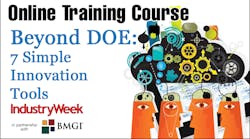Note: Learn more about these principles in IW's Online Training session Beyond DOE: 7 Simple, Effective Innovation Tools.
Are your improvement initiatives feeling stale? Incorporating innovation tools will help you generate potential, novel solutions and ultimately improve your process, product or service. Here are seven simple, effective innovation tools that you can apply in your next project.
1. Job To Be Done: Find the Customer’s True Need
Customers don’t buy products or services; they hire solutions to complete the “Job To Be Done” (JTBD). This concept, popularized by Harvard Business School professor Clayton Christensen, helps move innovations beyond simply improving current solutions. For example, if the JTBD of a toothbrush is to clean one’s teeth, then instead of simply making a better toothbrush, what other solutions might be possible? When you start thinking in terms of the JTBD, you can gain new insights and ideas on innovative ways to meet your customers’ needs. Learn more about the JTBD in this excerpt from The Innovator’s Toolkit and download a template here.
2. Outcome Expectations: Give Them More of What They Want
Outcome Expectations are those expectations that surround getting a particular job done. For example, the job of “cleaning your clothes” has several outcome expectations, such as “minimize the time it takes to clean clothes” and “increase the likelihood of stain removal.” There can also be outcomes that are undesired, such as damaged clothes or a foul-smelling odor. When you give the customer more of what they desire—and less of what they don’t—you provide solutions that create more value and satisfaction. Learn more about Outcome Expectations in this excerpt from The Innovator’s Toolkit and download a template here.
3. Ideal Final Result: Start With the End in Mind
The Ideal Final Result is just what it sounds like: the perfect solution. Derived from the Theory of Inventive Problem Solving, commonly known as TRIZ, the Ideal Final Result is a starting point from which you can work backwards. Don’t start where you already are; start at the ideal end.
4. Brain Writing 6-3-5: Encourage Equal Opportunity Ideation
In Brain Writing 6-3-5, each person has five minutes to write down three ideas in a written format. This is great for team members who have varied ideas or for teams composed of a mixture of extroverts and introverts. The exercise ensures the group isn’t dominated by certain participants or that others are allowed to hold back. At the end, you could have as many as 108 new ideas. Download a Brain Writing 6-3-5 template here.
5. SCAMPER: Teach an Old Dog New Tricks
When you have an idea that you need to make stronger, SCAMPER is a great tool for evolving your existing solution into one that is superior. This acronym stands for: Substitute, Combine, Adapt, Modify, Put to other purposes, Eliminate, Rearrange. Within each of those areas, SCAMPER helps you develop a set of directed questions, such as “What can I substitute to make an improvement?” In the end, you’ll have a list of ideas that you can refine and further develop. Download a SCAMPER worksheet here.
6. Random Stimulus: Use an Unrelated Signal to Spawn New Ideas
People naturally establish patterns and ways of thinking. Random Stimulus is a tool designed to move people out of their current zones. Here’s how it works: Choose a word, image, sound or smell and have your team brainstorm associations. Then discuss how those associations could generate ideas that relate back to your problem/solution. While this method might seem too disconnected for some, it’s a great way to spark novel ideas.
7. Six Thinking Modes: Put On a Different ‘Hat’
This tool lets you see different points of view so the team can choose its best ideas. Team members are asked to adopt a metaphorical hat that represents a mode of thinking, ensuring that every idea will be evaluated by the criteria of judgment, optimism, information, emotions, creativity and process. Six Thinking Modes works especially well with controversial ideas because it allows for objectivity and evaluation of pros and cons.
Next time you’re planning an improvement initiative, consider how you might freshen up your effort with these tools. You’ll not only help unleash your team’s creative potential, but also instill an innovation mind-set within your organization.
Renee Snell is a principal with operational strategy firm BMGI. A statistician and Master Black Belt with more than 20 years of experience, she has developed and taught continuous improvement techniques to hundreds of practitioners and led many projects to solve problems quickly.



